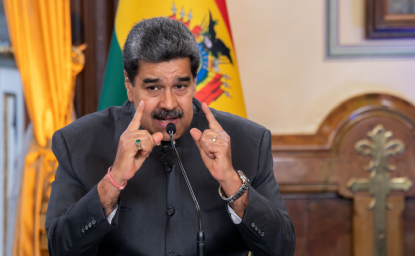Today, the term ‘de-risking’ is most often associated with European Commission President von der Leyen’s strategy to reduce the EU’s economic reliance on China. However, von der Leyen was not the first to champion this term. De-risking has long been used to describe the lesser-known trend of banks cutting their ties to ‘high risk’ jurisdictions, often those suffering from hardship and conflict. This type of de-risking not only amplifies humanitarian problems in the affected regions, but also increasingly threatens a number of strategic EU interests, including its geoeconomic standing.
While a severe and pressing issue, bank de-risking can nevertheless be tackled with tangible approaches. This would not only mitigate its effects but arguably enhance the EU's foreign policy and security. For policymakers, addressing the problem is more important now than ever.
What causes bank de-risking?
The recent increase in sanctions, as well as Anti-Money Laundering (AML) and Countering the Financing of Terrorism (CFT) regulations has resulted in an intricate legal environment, especially for Western banks. This has caused them to be reluctant in providing services to actors operating in countries perceived as ‘high risk’ compliance wise, such as those which lack transparency, regulatory oversight, are known for being sanctions circumvention hubs or harboring terrorists.
At a minimum, maintaining ties to individuals, companies and NGOs acting within these jurisdictions entail significantly higher compliance costs. The more pressing concern for banks, however, is the very real risk that money channeled into these countries might ultimately end up in the hands of a sanctioned entity, criminal or a terrorist organization. In this case, the bank would be liable regardless of its efforts to prevent such outcomes.
The stakes here are considerable. Violations of AML/CFT laws can carry fines in the billions and significant reputational cost. Additionally, European banks face severe consequences not only for breaching extensive EU sanctions, but also US sanctions. This is due, in part, to the latter’s use of so-called ‘secondary sanctions’, through which an entity transacting with US sanctioned entities can face the same consequences as those directly targeted by sanctions. This means losing access to the dollar, which dominates international transactions, and the critical US financial market. In one notable example, Latvia's third largest bank at the time went under in only eleven days following accusations of non-compliance by US financial authorities. The mere prospect of it being cut off from dollar-denominated transactions caused a bank run which forced the institution into liquidation. Other European banks have managed to avoid similar fates, but still paid hefty settlements for US sanctions breaches.
For many banks, having connections to high-risk jurisdictions therefore translates into higher costs, meager revenues and the potentially existential threat of exclusion from crucial financial systems. Consequently, they cut ties to these regions - or de-risk - by closing branches, refusing to process transactions or terminating their Correspondent Banking Relationships. The latter are arrangements where banks hold deposits of foreign banks and provide them with services, such as cross-border payment processing. CBRs are essential for many local banks, and by extension, their home jurisdictions, in accessing key financial markets and currencies around the world.
De-risking explains how countries such as Syria, Afghanistan, Yemen, Somalia, Sudan, Cuba, Venezuela, Iran or North Korea have been almost entirely cut off from the global financial system, which has severe ramifications.
Consequences of bank de-risking
Losing access to banking channels is detrimental to any community, but especially those already affected by conflict or hardship. First, de-risking is a principal obstacle to financial inclusion, poverty reduction and economic growth, while also hindering investment and the provision of insurance services to a certain region. This, in turn, drives human rights abuses such as modern slavery and human trafficking while contributing to migratory pressures. Moreover, de-risking impedes humanitarian actors from carrying out their activities at the necessary scale or speed, and has a "chilling effect" on their donors.
The fact that entire populations are affected in this way can also delegitimize the Union’s sanctions, which the EU claims are narrowly targeted only at culpable entities. Indeed, several disinformation campaigns have pushed the narrative that the plight of third countries following disruptions to global markets are a direct result of Western sanctions. This jeopardizes the EU's efforts to align these countries with its foreign policy, for example in relation to Russia.
Finally, de-risking poses potential strategic and security challenges for Europe. EU-based banks withdrawing from jurisdictions leaves ample room for geopolitical competitors to fill the resulting vacuum. This may diminish Europe’s financial relevance on the global arena at a time when the Union conversely is seeking to bolster its international competitiveness. Relatedly, this shift favors actors pursuing a global financial system less reliant on the dollar, which would decrease the G7's economic leverage, particularly its sanctions. Additionally, entities that lose access to regular banking channels become reliant on less regulated forms of payment, which poses an illicit finance risk.
The need for a comprehensive approach on an EU level
As the global economy becomes more fragmented, with increasing sanctions and greater geopolitical influence on corporate decision making, the issues described above are likely to aggravate in the future. Tackling de-risking is therefore acute, yet it remains challenging as it cuts across a wide selection of policy areas, each the focus of distinct EU departments: humanitarian operations (DG ECHO), migration flows (DG NEAR), sanctions (EEAS, DG FISMA as well as EU’s Sanctions Envoy), trade relations (DG TRADE) and illicit finance (DG FISMA), to name a few.
Last year, the US, for its part, sought to address de-risking more holistically by developing its first-ever ‘de-risking strategy’, which consolidates knowledge across governmental institutions and sectors. The EU, being a significant economic power and a champion of humanitarian issues, should publish a corresponding strategy of its own, which could include elements discussed below. While the EU might have already integrated some of these approaches into its policymaking, a unified strategy would solidify them into standard practice.
Areas of focus for an EU de-risking strategy
First, the EU should make trisector consultations between authorities, banks and humanitarian actors a focal point of a future de-risking strategy. Such dialogues would allow policymakers to better understand the rationale underpinning correspondent banks’ decisions to stay in or leave a region. They could also help address misunderstandings financial institutions hold; For example, many banks perceive hawala, a payment system crucial for delivering humanitarian aid, as a breeding ground for terrorism financing. Multi-stakeholder engagement groups have been used to high effect in addressing de-risking challenges in the UK, Netherlands and the US, with new ones recently established in France, Germany, Switzerland and Sweden. The Union would benefit from enabling EU-wide trisector groups, both by supporting those already instituted and encouraging the creation of new ones.
Trisector consultations could also provide a platform for exploring creative approaches. For example, participants could consider how to cater to banks’ Environmental, Social, and Governance (ESG) commitments by promoting those staying in hardship countries as facilitating humanitarian aid. In addition to banks, consultations could extend to private sector actors which are actually incentivized to promote financial inclusion, such as credit card companies or innovative fintech enterprises.
Second, an EU bank de-risking strategy could entail more international engagement on the part of the Union, with the goal of creating safer cross-jurisdictional operating environments for banks. For example, the EU could push for more adaptation of recognized standards on AML/CFT among states within international bodies, such as the Financial Action Task Force.
Bilaterally, the EU should seek to deepen its engagement with the US. As stated previously, a main driver of de-risking among European banks is the fear of breaching US sanctions. This is something that the US now seems keen to address, with the Treasury’s de-risking strategy problematizing the fact that banks perceive US sanctions regimes as "unforgiving" towards non-compliance. This gives the EU political momentum to lobby for measures which could make European banks more secure in operating in financially excluded jurisdictions. For instance, an EU de-risking strategy could entail the Union seeking guarantees from US authorities that European banks will not immediately be penalized for minor breaches done in good faith, especially if said breaches occur in a de-risked country.
Finally, it is essential to recognize that tackling de-risking should not involve walking back on policies such as sanctions or AML/CFT, as they are vital for upholding global norms and security. An EU de-risking strategy should nevertheless implement processes for regulatory review to explore how to reduce the de-risking effect of certain policies, without undermining their core objectives. The humanitarian exemptions implemented into EU sanctions regimes following the celebrated UN Security Council Resolution 2664 is a welcome first step, but further revisions are needed.
The timing is right
Given the Union’s vows to pursue greater economic security while limiting “any negative unintended spill-over effects”, addressing bank de-risking is all the more timely. Notably, an EU de-risking strategy would perfectly align with von der Leyen’s recently released political guidelines for the 2024-2029 Commission, which calls for a “more systematic approach to assessing the impact of [EU] laws on non-EU countries”.
Tackling bank de-risking would further solidify the Union’s image as a global proponent of humanitarian issues, while enhancing its foreign and security policy. Additionally, it would showcase the Union’s adaptability and responsibility in an era of increased geoeconomic competition. In this sense, achieving von der Leyen’s notion of de-risking should run parallel with curbing bank de-risking.
Authors



Global Europe Program
The Global Europe Program is focused on Europe’s capabilities, and how it engages on critical global issues. We investigate European approaches to critical global issues. We examine Europe’s relations with Russia and Eurasia, China and the Indo-Pacific, the Middle East and Africa. Our initiatives include “Ukraine in Europe”—an examination of what it will take to make Ukraine’s European future a reality. But we also examine the role of NATO, the European Union and the OSCE, Europe’s energy security, transatlantic trade disputes, and challenges to democracy. The Global Europe Program’s staff, scholars-in-residence, and Global Fellows participate in seminars, policy study groups, and international conferences to provide analytical recommendations to policy makers and the media. Read more

Explore More
Browse Insights & Analysis
360° View of How Southeast Asia Can Attract More FDI in Chips and AI





